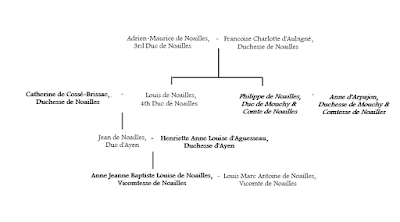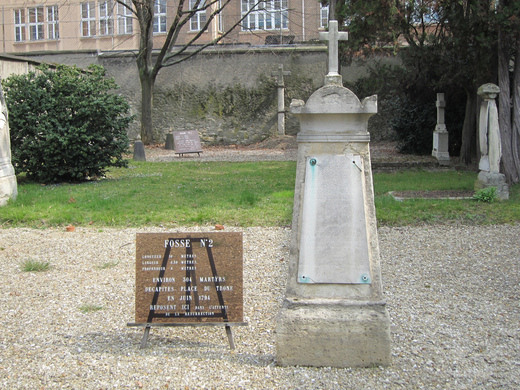The House of Noailles was a highly distinguished family in the French nobility and had held important positions at court for centuries. It also had the dubious honour of losing five of its most prominent members to the guillotine. What is remarkable is that due to the family's good connections - and after all some surviving members - their last days were well-documented.
Louis de Noailles - who was the reigning Duc de Noailles during the revolution - would undoubtedly have followed his family onto the scaffold had he not died from natural causes in 1793. The family members he left behind were not so lucky. Their executions took place on these dates:
27 June 1794 = Philippe de Noailles and Anne d'Arpajon
22 July 1794 = Catherine de Cossé-Brissac
Henriette Anne Louise d'Aguesseau
Anne Jeanne Baptiste Louise de Noailles
27 June 1794 = Philippe de Noailles and Anne d'Arpajon
22 July 1794 = Catherine de Cossé-Brissac
Henriette Anne Louise d'Aguesseau
Anne Jeanne Baptiste Louise de Noailles
Those who did lose their lives under the blade of the guillotine were closely related and spanned over three generations. To make it easier to understand their relation to one another I have made this simplified family tree:
 |
| The women who were executed on 22 July 1794 are written in bold. Philippe and Anne were also executed but on 27 June |
When Louis de Noailles, fourth Duc de Noailles died in 1793 his widow moved to their family hôtel in Paris. She was accompanied by the Duchesse d'Ayen and the Vicomtesse de Noailles. It was intended that the Vicomtesse was to go to England where her husband was already waiting for her. From there they would continue to the newly independent colonies in America. It is very likely that her mother, the Duchesse d'Ayen, would have gone with her but something occurred to delay them. The Duchesse de Noailles was by this time very fragile and her mind had begun to fail. Being in her seventies she had been dependent on her husband and with his passing she would otherwise had been left to fend for herself. She had already begun to show signs of dementia which only aggravated how vulnerable she would be on her own.
The Duchesse d'Ayen refused to leave her mother-in-law behind in France and in turn the Vicomtesse would not leave her mother. The result was that they remain in France; it proved to be a fatal decision.
During their time at the hôtel de Noailles they were often in the company of the Abbé Carrichon who had been the confessor of the Duchesse d'Ayen before the revolution. During his employ he had become very attached to his mistress and continued to offer the family consolation and diversion throughout the tumults around them.
In the end the three ladies could not escape the attention of the National Assembly. On 6 April 1794 they were arrested; eventually they were transferred to the hôtel de Luxembourg which now served as a prison for the aristocracy. Here, they found two of their relatives already incarcerated: the Comte and Comtesse de Noailles. The family seemed to enjoy the reunion despite the circumstances. The three ladies were given rooms directly above those of their relations.
During this time the Abbé Carrichon continued his visits; he promised the Duchesse d'Ayen that should the worst happen he would do his utmost to be present to give one final absolution.
The Duchesse d'Ayen refused to leave her mother-in-law behind in France and in turn the Vicomtesse would not leave her mother. The result was that they remain in France; it proved to be a fatal decision.
During their time at the hôtel de Noailles they were often in the company of the Abbé Carrichon who had been the confessor of the Duchesse d'Ayen before the revolution. During his employ he had become very attached to his mistress and continued to offer the family consolation and diversion throughout the tumults around them.
| The Duchesse d'Ayen |
In the end the three ladies could not escape the attention of the National Assembly. On 6 April 1794 they were arrested; eventually they were transferred to the hôtel de Luxembourg which now served as a prison for the aristocracy. Here, they found two of their relatives already incarcerated: the Comte and Comtesse de Noailles. The family seemed to enjoy the reunion despite the circumstances. The three ladies were given rooms directly above those of their relations.
During this time the Abbé Carrichon continued his visits; he promised the Duchesse d'Ayen that should the worst happen he would do his utmost to be present to give one final absolution.
All five were transferred to the Conciergerie in May; the transfer was not received well and with good cause. The Conciergerie had become known as the final stop before the guillotine; Marie Antoinette had spent her last days her the year previously. Their suspicions were confirmed when they were all sentenced to die by the guillotine.
The first to be executed were the Comte and Comtesse de Noailles. Little is known about the exact details of their executions except that they were both executed on 27 June and on the same location. In the end they were buried in the mass grave of Picpus Cemetery.
Thanks to partly to the eye-witness account of the Abbé Carrichon and the memoirs of the Marquise de Montagu - daughter to the Duchesse d'Ayen and as such sister to the Vicomtesse - we know far more about the executions of the three remaining Noailles-prisoners.
The day fixed for their executions was 22 July 1794. Two carts had been driven to the gates of the Conciergerie for the condemned. The Duchesse de Noailles was put in the first one with seven other women. The Duchesse d'Ayen (wearing a white/blue striped morning dress) and her daughter (completely in white) were seated on the second one. As the carts rumbled through the streets the skies darkened; still, the Duchesse d'Ayen could not spot the Abbé in the crowd. On the way there a storm broke out which thinned out the crowd of spectators. This revealed the well-known figure of the Abbé to the ladies in the second cart. He gave the signal they had agreed to and the Duchesse d'Ayen and her daughter knelt down in the cart. From afar the Abbé gave a final absolution and blessed them before the carts moved on.
 |
| Anne d'Arpajon - better known as Madame Etiquette or the Comtesse de Noailles |
The first to be executed were the Comte and Comtesse de Noailles. Little is known about the exact details of their executions except that they were both executed on 27 June and on the same location. In the end they were buried in the mass grave of Picpus Cemetery.
Thanks to partly to the eye-witness account of the Abbé Carrichon and the memoirs of the Marquise de Montagu - daughter to the Duchesse d'Ayen and as such sister to the Vicomtesse - we know far more about the executions of the three remaining Noailles-prisoners.
 |
| Philippe, Comte de Noailles |
The day fixed for their executions was 22 July 1794. Two carts had been driven to the gates of the Conciergerie for the condemned. The Duchesse de Noailles was put in the first one with seven other women. The Duchesse d'Ayen (wearing a white/blue striped morning dress) and her daughter (completely in white) were seated on the second one. As the carts rumbled through the streets the skies darkened; still, the Duchesse d'Ayen could not spot the Abbé in the crowd. On the way there a storm broke out which thinned out the crowd of spectators. This revealed the well-known figure of the Abbé to the ladies in the second cart. He gave the signal they had agreed to and the Duchesse d'Ayen and her daughter knelt down in the cart. From afar the Abbé gave a final absolution and blessed them before the carts moved on.
The Duchesse de Noailles could not see the Abbé; it is not entirely certain that she was aware or remembered the agreement. The rising winds had blown her cap off leaving the rain to splash directly into her face. Her hands had already been tied behind her back so she was completely exposed to the elements.
 |
| The Duchesse de Noailles at the age of 70 - this is how she looked around the time she was executed |
Once the carts arrived at the Barrière du Thrône the scaffold came into full view. On top of it the executioner and his two assistants were waiting. The first cart unloaded and the executions began. Due to her condition the Duchesse de Noailles was allowed to sit on a wooden bench while two other women climbed the ladder. The aged Duchesse kept her eyes on the ground and remained dignified despite the insults hurled at her by spectators. She then stepped onto the scaffold; the executioner had to cut away the top part of her dress to completely expose her neck.
The Duchesse d'Ayen was the tenth woman to be executed that day. She, too, was resigned and dignified. The executioner removed her cap but had not noticed that it had gotten stuck in her hair; he tore it off which produced the only expression of pain that crossed her face that day. Her hands were then tied behind her back and she was beheaded.
The poor Vicomtesse had now seen both her grand-mother and her mother being decapitated. She was to follow immediately behind her mother. She stepped onto the ladder when a blasphemous comment from a bystander made her pause. She turned and said "For mercy's sake, ask pardon" before continuing her climb to her death.
The three ladies were buried in the same mass grave as the Comte and Comtesse de Noailles.
The Duchesse d'Ayen was the tenth woman to be executed that day. She, too, was resigned and dignified. The executioner removed her cap but had not noticed that it had gotten stuck in her hair; he tore it off which produced the only expression of pain that crossed her face that day. Her hands were then tied behind her back and she was beheaded.
The poor Vicomtesse had now seen both her grand-mother and her mother being decapitated. She was to follow immediately behind her mother. She stepped onto the ladder when a blasphemous comment from a bystander made her pause. She turned and said "For mercy's sake, ask pardon" before continuing her climb to her death.
The three ladies were buried in the same mass grave as the Comte and Comtesse de Noailles.
 |
| Memorial stone of a mass grave in the Picpus Cemetery |

How is Marie D'Ayaen Noailles who escaped to America related?
ReplyDeleteWas Rachiel Noailles, the wife of Matthias Brickell, in America, related to this family? If so, how? Many thanks. Robert Demler robertcdemler@gmail.com
ReplyDelete